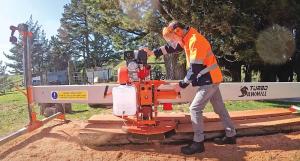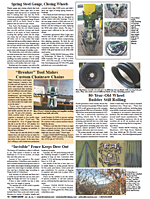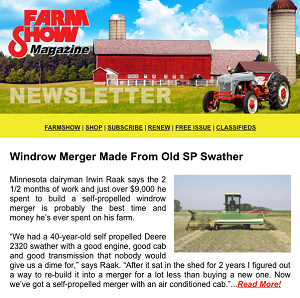Swing-Blade Sawmill Makes Milling Simple
 ✖  |
When Austin Mehlhorn stumbled across Turbosawmill’s swing-blade sawmill, he knew it would fit his needs. The New Zealand-designed and built Turbosawmill requires little maintenance and is easy to operate. With its open sides, no loading logs onto a table or carriage is needed. Likewise, there are no hydraulics to increase costs.
“With a swing-blade sawmill, you just walk the blade down for a horizontal cut and walk it back in a vertical position, and you have a finished piece of lumber,” explains Mehlhorn. “With the Turbosawmill, just roll the log underneath, adjust the end frames to match the size and taper of the log and start milling.”
Mehlhorn works full-time in his local school system and does custom sawmill work in the summer. Because the Turbosawmill is so simple, he can rent it out to others during the school year.
“I can drop it off, spend an hour of training and let them go,” says Mehlhorn. “When doing custom milling, I can pull into the yard, push it into place and go to work.”
Mehlhorn had considered bandsaw sawmills and other makes of swing-blade mills. He hesitated due to the high costs and knowing he would often be milling residential trees. He expected to encounter metal in the wood. That ruled out bandsaw mills. The swing-blade Turbosawmill was priced right, and it had replaceable teeth.
“I can hit a piece of metal, and it may wreck one or two teeth,” he says. “I just sharpen the remaining teeth right on the blade and move on. Teeth cost around $100 each, but if I don’t hit metal, they’ll usually last multiple months, even with daily use.”
Learning how to sharpen the Turbosawmill teeth was easy, adds Mehlhorn. “The mill has a decent amount of tolerance on sharpening and still turns out a consistent product.”
Turbosawmill offers multiple models, with standard cuts ranging from 6 by 6 in. with the M6-13M to 12 by 12 in. with the M12-28A. If equipped (in the case of the M6) or operated in double-cut mode (some other models are double-cut capable), the swing-blade sawmills can produce cants ranging from 5 by 12 in. to 11 by 24 in.
The M6, with an 11-hp. engine, is designed to mill logs up to 5 ft. in diameter and 14 ft. in length. However, any diameter may be sawn. The M12, with its 30-hp. gas engine, is designed for logs of up to 4 ft. in diameter and 20 ft. long, although it also can be used with larger diameter logs. It can be extended to cut logs up to 26 ft. long or longer with the addition of a center leg.
Mehlhorn likes the portability of Turbosawmill models. The power carriage operates on a beam suspended from two end frames.
One person can move the sawmills as needed, using the jockey transport wheels or towed behind a quad or small tractor.
The price includes delivery to the buyer’s door. The M6, with a delivery weight of 680 lbs., is priced at $11,000, and the M12, with a delivery weight of 2,200 lbs., is priced at $35,000.
Mehlhorn was so satisfied with his Turbosawmill M10 that he became one of two U.S. technical sales reps for the company. “We have customers in all 50 states,” he says. “The website lists customers willing to talk to prospects about their sawmill.”
Contact: FARM SHOW Followup, Turbosawmill USA, Spokane, Wash. (ph 509-530-1807 or toll-free 833-961-1904; jake@turbosawmill.com or stan@turbosawmill.com; www.turbosawmill.com) or Swift Fox Industries, 4501-46 Ave., Vermilion, Alberta, Canada T9X 1J2 (ph 780-853-3699 or 780-674-1568; office@swiftfoxindustries.ca; www.swiftfoxindustries.ca).

Click here to download page story appeared in.
Click here to read entire issue
Swing-Blade Sawmill Makes Milling Simple WOODLOT EQUIPMENT Saws When Austin Mehlhorn stumbled across Turbosawmill’s swing-blade sawmill he knew it would fit his needs The New Zealand-designed and built Turbosawmill requires little maintenance and is easy to operate With its open sides no loading logs onto a table or carriage is needed Likewise there are no hydraulics to increase costs “With a swing-blade sawmill you just walk the blade down for a horizontal cut and walk it back in a vertical position and you have a finished piece of lumber ” explains Mehlhorn “With the Turbosawmill just roll the log underneath adjust the end frames to match the size and taper of the log and start milling ” Mehlhorn works full-time in his local school system and does custom sawmill work in the summer Because the Turbosawmill is so simple he can rent it out to others during the school year “I can drop it off spend an hour of training and let them go ” says Mehlhorn “When doing custom milling I can pull into the yard push it into place and go to work ” Mehlhorn had considered bandsaw sawmills and other makes of swing-blade mills He hesitated due to the high costs and knowing he would often be milling residential trees He expected to encounter metal in the wood That ruled out bandsaw mills The swing-blade Turbosawmill was priced right and it had replaceable teeth “I can hit a piece of metal and it may wreck one or two teeth ” he says “I just sharpen the remaining teeth right on the blade and move on Teeth cost around $100 each but if I don’t hit metal they’ll usually last multiple months even with daily use ” Learning how to sharpen the Turbosawmill teeth was easy adds Mehlhorn “The mill has a decent amount of tolerance on sharpening and still turns out a consistent product ” Turbosawmill offers multiple models with standard cuts ranging from 6 by 6 in with the M6-13M to 12 by 12 in with the M12-28A If equipped in the case of the M6 or operated in double-cut mode some other models are double-cut capable the swing-blade sawmills can produce cants ranging from 5 by 12 in to 11 by 24 in The M6 with an 11-hp engine is designed to mill logs up to 5 ft in diameter and 14 ft in length However any diameter may be sawn The M12 with its 30-hp gas engine is designed for logs of up to 4 ft in diameter and 20 ft long although it also can be used with larger diameter logs It can be extended to cut logs up to 26 ft long or longer with the addition of a center leg Mehlhorn likes the portability of Turbosawmill models The power carriage operates on a beam suspended from two end frames One person can move the sawmills as needed using the jockey transport wheels or towed behind a quad or small tractor The price includes delivery to the buyer’s door The M6 with a delivery weight of 680 lbs is priced at $11 000 and the M12 with a delivery weight of 2 200 lbs is priced at $35 000 Mehlhorn was so satisfied with his Turbosawmill M10 that he became one of two U S technical sales reps for the company “We have customers in all 50 states ” he says “The website lists customers willing to talk to prospects about their sawmill ” Contact: FARM SHOW Followup Turbosawmill USA Spokane Wash ph 509-530-1807 or toll-free 833-961-1904; jake@turbosawmill com or stan@turbosawmill com; www turbosawmill com or Swift Fox Industries 4501-46 Ave Vermilion Alberta Canada T9X 1J2 ph 780-853-3699 or 780-674-1568; office@swiftfoxindustries ca; www swiftfoxindustries ca
To read the rest of this story, download this issue below or click
here to register with your account number.







